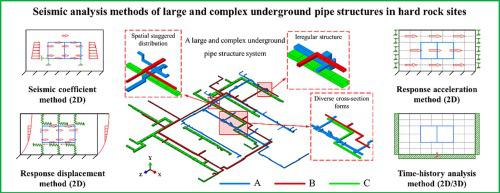Tunnelling and Underground Space Technology ( IF 6.7 ) Pub Date : 2023-02-13 , DOI: 10.1016/j.tust.2023.105035 Peng Ding , Cheng Shi , Lianjin Tao , Zhiguo Liu , Tao Zhang

|
In order to study the seismic design methods of large and complex underground pipe structures (LCUP) in hard rock sites, firstly, the structural characteristics of LCUP and the calculation principles of four typical seismic analysis methods were carefully sorted out. Secondly, based on different seismic analysis methods, the deformation and internal force response of three representative pipes were studied in detail, and the calculation accuracy and error causes of each seismic analysis method were analyzed. Finally, the advantages, disadvantages and applicability of the seismic analysis methods on typical pipes were systematically explained, and the technical route for seismic design of LCUP was proposed. The results showed that both the reaction displacement method and the reaction acceleration method can effectively analyze the seismic performance of standard section structures. The three-dimensional time-history analysis method was comprehensive and highly accurate for seismic analysis of complex spatial cross-node structures. The rigid connections of different pipes leaded to serious discontinuities in stiffness at the intersection, and the deformation and bending moment distributions were highly concentrated at the height away from the intersection. The influence range of the intersection was about three times the width of the intersection, and LCUP was classified according to this influence range. For standard section structures, seismic analysis should be carried out using the reaction acceleration method or reaction displacement method, while for spatial cross-node structures, three-dimensional time-history analysis should be used for seismic analysis. This scientific seismic design method achieved multiple optimal balances of seismic safety, analysis accuracy, efficiency and economy in the seismic analysis of large and complex underground structures. A theoretical basis and useful reference for the scientific design, accurate prediction and seismic safety evaluation of seismic response of LCUP were provided in this paper.
中文翻译:

硬岩场地大型复杂地下管道结构抗震分析方法研究
为研究硬岩场地大型复杂地下管道结构(LCUP)的抗震设计方法,首先对LCUP的结构特点和四种典型抗震分析方法的计算原理进行了认真梳理。其次,基于不同的抗震分析方法,对三种具有代表性的管道的变形和内力响应进行了详细研究,分析了每种抗震分析方法的计算精度和误差原因。最后系统阐述了典型管道抗震分析方法的优缺点及适用性,提出了LCUP抗震设计的技术路线。结果表明,反作用位移法和反作用加速度法均能有效地分析标准截面结构的抗震性能。三维时程分析方法对复杂空间交叉节点结构的抗震分析具有综合性、准确性高的特点。不同管道的刚性连接导致交叉处刚度严重不连续,变形和弯矩分布高度集中在远离交叉口的高度。交叉口的影响范围大约是交叉口宽度的3倍,LCUP就是根据这个影响范围进行分类的。对于标准截面结构,应采用反作用加速度法或反作用位移法进行抗震分析,而对于空间交叉节点结构,应采用三维时程分析进行抗震分析。这种科学的抗震设计方法在大型复杂地下结构抗震分析中实现了抗震安全性、分析精度、效率和经济性的多重优化平衡。为LCUP地震响应的科学设计、准确预测和地震安全性评价提供理论依据和有益参考。











































 京公网安备 11010802027423号
京公网安备 11010802027423号